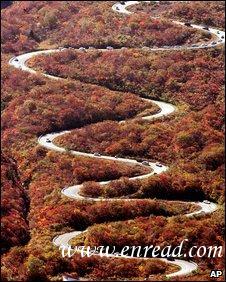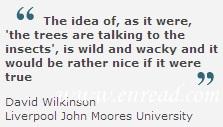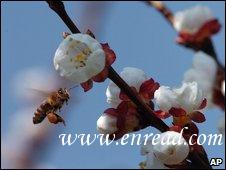| ||||||||||||||||||||||||||||||||||||||||||||||||||||||||||||||||||||||||||||||||||||||||||||||||||||||||||||||||||||||||||||||||||||||||||||||||||||||||||||||||||||||||
|
The long-standing debate about why autumn leaves change colour has new impetus1 from the humble2 apple tree. 长期存在的关于秋季树叶颜色变化的争论从谦逊的苹果树上有了新的推力。 Domesticated3(驯服的,驯养的) apples - selectively bred for fruit size and taste rather than insect defence - tend to have less red leaves than their wild cousins. Researchers suggest that fact supports one theory for the change: that autumn's red colours ward5(守卫,监护) off insects, indicating a plant's chemical defences. The research is published in Proceedings6 of the Royal Society B. However, other experts remain sceptical(怀疑的) of this "co-evolution" theory. The idea, taking into account the full range of autumn colours, was first suggested in 2001 by the late biologist Bill Hamilton. More recent research, however, has shown that autumn's oranges and yellows are caused by carotenoids(类胡萝卜素). These are pigment7(色素,颜色) molecules8(分子学) present year-round, normally serving to protect chlorophyll(叶绿素) - the green-coloured molecule9 at the heart of photosynthesis10(光合作用) - from damage caused by sunlight. In the autumn, as chlorophyll is actively11 broken down in the leaves, the carotenoids become visible. Autumn's brilliant reds and purples, however, are caused by molecules called anthocyanins(花青素) that are produced during the same period. It is a costly12 job of molecule building for the plant and an enigma13(不可理解的人或事) to scientists, since the leaves will at that point soon be dropped entirely14. "If you wanted to prove this hypothesis that the autumn colours are necessary to repel15(逐退,反驳) insects, what you would do is take two populations of trees and let them evolve - one with and one without the insects - expecting the one without insects would lose its colours," said author of the research Marco Archetti, of the University of Oxford's zoology16(动物学) department. "That's exactly what's been done starting 2,000 years ago when they started to domesticate4(养驯,狡猾) apple trees, because they've been sheltered from the influence of insects and parasites(寄生虫)," Dr Archetti explained. "There is no longer natural selection; what is going on is artificial selection by the farmer for fruit size and flavour, not resistance against insects." Cue(开端,线索) controversy17(争议,争论) David Wilkinson, an environmental scientist at Liverpool John Moores University who has published on the leaf colour debate, says that the work is not proof positive of the co-evolution theory. "There's a difference between a 'signal' and a 'cue'," he explained. "A cue is something that hasn't evolved for a signalling function but is used by something else as information that affects its behaviour. "But that doesn't mean that the autumn colour has evolved for that purpose." Dr Wilkinson points out that a competing theory holds that anthocyanins are performing a different task altogether. Plants are known to break down components18 of their leaves and harvest a number of precious compounds - particularly those containing nitrogen(氮) - before cutting the leaves loose entirely. Apricot and walnut19 trees may also have lost their reds in domestication20 "I think the most likely explanation is that these [anthocyanins] are effectively sunscreens(遮光剂) that allow the photosynthesis to continue as the machinery21 of photosynthesis is broken apart in the autumn. "The idea of, as it were, 'the trees are talking to the insects', is wild and wacky(古怪的,愚蠢的) and it would be rather nice if it were true. "But I still have not seen anything that convinces me of the signalling." Dr Archetti believes that the loss of red leaves among domesticated plants cannot be explained by the "photoprotection(光照保护法)" theory favoured by Dr Wilkinson. He now intends to study apricot(杏) and walnut(胡桃) trees, the domesticated varieties of which he says have also experienced the loss of autumn's reds. 点击  收听单词发音 收听单词发音
|
||||||||||||||||||||||||||||||||||||||||||||||||||||||||||||||||||||||||||||||||||||||||||||||||||||||||||||||||||||||||||||||||||||||||||||||||||||||||||||||||||||||||
上一篇:为什么照片上眼睛是红的 下一篇:登山对大脑不利? |
||||||||||||||||||||||||||||||||||||||||||||||||||||||||||||||||||||||||||||||||||||||||||||||||||||||||||||||||||||||||||||||||||||||||||||||||||||||||||||||||||||||||
- 发表评论
-
- 最新评论 进入详细评论页>>






